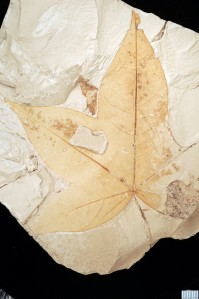
We all must have had in a point of our life heard about how extinct organisms remains become fossilized, either by books, movies or even in the Discovery or History channel. There are many different types of fossilization processes including Permineralization, Cast and Molds, Replacements and Crystalization, and Carbonization, We often encounter these in the context of animal shells or bones, but what we hardly ever hear about is the preservation plant fossils. Plants, just as the megafauna, can be preserved in the rocks. Typical plant fossils are wood, seeds, roots, flowers, pollen, and leaves which are by far the most commonly preserved macroscopic plant part.
Plant fossils are commonly preserved in fluvial or deltaic systems where rivers deposit sediment. Many of the best leaves are preserved in abandoned river channels that form oxbow lakes. The fossilized leaves from Tennessee that I am studying were collected from oxbow lake deposits. In these oxbow lakes the plant parts are deposited gently in fine-grained sediment and can be preserved with excellent detail. As the sediment is buried by further flooding events water is squeezed out of the sediment and the internal structure of the leaf is squashed. Eventually, only a thin carbonaceous film that will outline the original plant structure.This fossilization process is known as compression. If the grains of sediment are large and angular the fossilized leaf will have poor detail, but the grains are smooth and fine, as is typical in oxbow lake deposits, the fossil will be full of detail that will help in identification.

The ability to identify fossils is controlled largely by the quality of preservation. In the case of leaves, the best way to identify the species is to describe the leaf characters such as shape, size, leaf attachment, lobation, the type of margin, and the venation pattern. Leaves come in many shapes which is the measurement of the leaf length from the base to the apex. These can be divided into four main shape: Elliptic, the widest part of the leaf is at the middle of the leaf; Ovate, the widest part of the leaf is near the base; Oblong, the opposite margins near the middle of the leaf run parallel having the same width; Obovate, the widest part of the leaf is near the apex. Also the lobation of a leaf is a great way for identification. A lobe is a marginal projection of the leaf where the sinus is increase into the leaf, these can be identified as Palmately Lobe, Pinnately Lobed or unlobed. Leaf margins can vary from toothed margin that have projections, known as teeth along the margin, or smooth margin which don’t have any kind of projections. Describing the vein architecture is another important way to distinguish and identifying species. Each species of leaf has its own vein architecture, almost like our fingerprints. The primary veins of leaves may be pinnate or palmate. The secondary veins may be Craspedodromous (secondary veins terminate at margin); Semicraspedodromous, (secondary veins branch near the margin); Eucamptodromous, (secondary veins do not branch or reach the margin); and Brochidodromous, (secondaries reach the margin forming loops and arches). Almost every species has a unique combination of these and other leaf architectural features.
One of the reasons we study fossil plants is to learn about the history of earth’s climate. Leaves in particular can be used to estimate climate variables like mean annual temperature and rainfall. Once we know all this we can compare the plant fossils with the megafauna fossils from a same location and learn about the interactions between the two of them. Such as understanding the megafauna’s migration cycles cause by the seasons that can be recorded in the plant fossils. We can understand very little of the planets past by only studying the megafauna, but by studying the fossil plant we begin to see the bigger picture, and if we connect the clues we can construct and fully understand the paleo-ecology of our ancient planet.

(Permineralization, is the replacement of tissues or cells by minerals; Cast and Molds, is when the organisms remains is destroyed and only the external mold and internal mold are preserved; Replacements and Crystalization, occurs when the shell or bone tissue is replace by another mineral; Carbonization, are the remains preserved in a thin layer of the chemical element of carbon.)